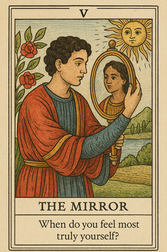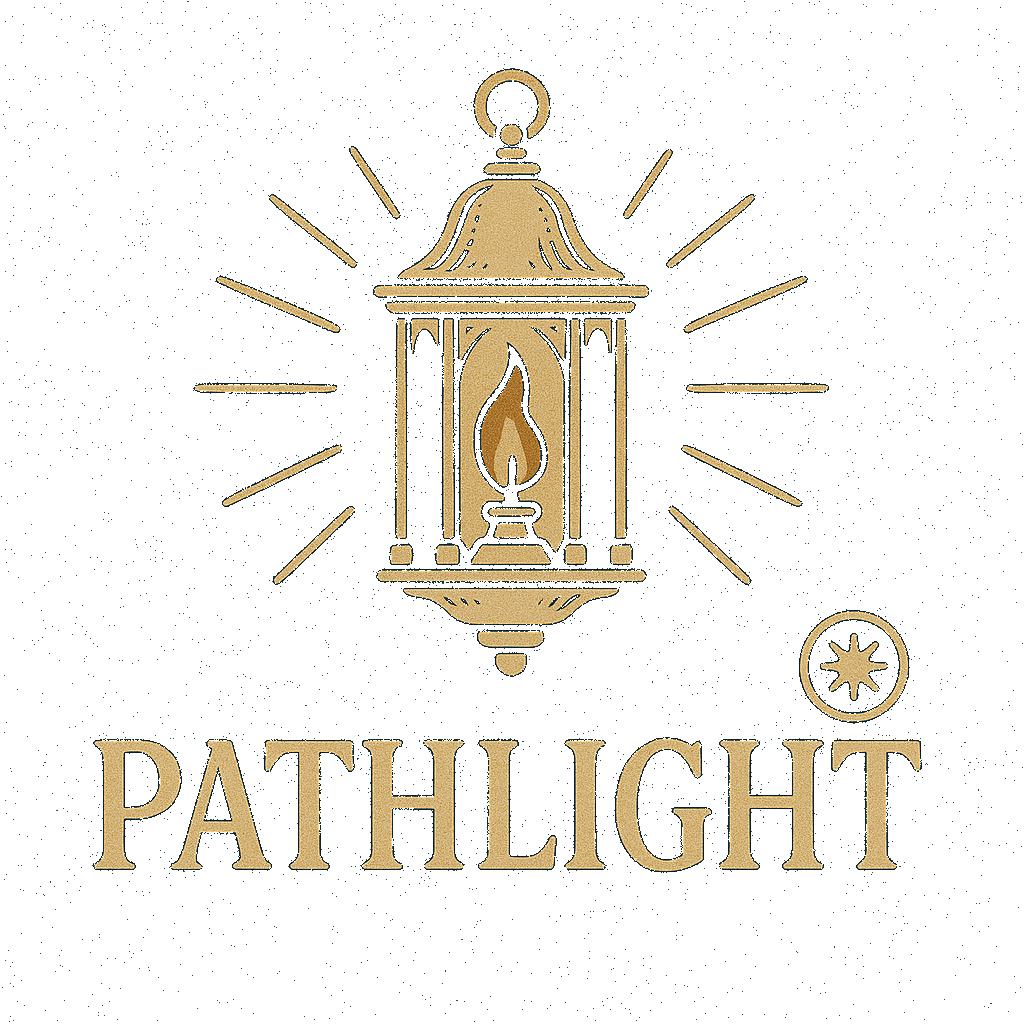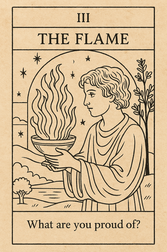How to Answer Reflective Questions: A Guide to Deeper Self-Discovery

Why Deep Reflection Matters
When you embark on a purpose discovery journey, the quality of your reflections directly impacts the insights you'll gain. Surface-level answers might feel safe and comfortable, but they rarely lead to the transformative realizations that can reshape your understanding of yourself and your path forward.
Research shows that people who engage in deeper reflection experience:
- Greater self-awareness and emotional intelligence
- More authentic decision-making aligned with their true values
- Enhanced ability to recognize patterns in their behavior and thinking
- Increased resilience when facing challenges
- More meaningful connections with others and their purpose
This guide will equip you with practical techniques to move beyond initial, superficial responses and access the rich insights that lie beneath the surface of your consciousness.
Prepare Your Reflection Environment
The environment you create for reflection significantly impacts your ability to access deeper thoughts and feelings. Consider both your physical and mental space:
Physical Space
Create a dedicated area that signals to your brain "it's time to reflect":
- Find a quiet corner free from distractions and interruptions
- Adjust lighting to a soft, comfortable level—natural light is ideal
- Minimize clutter in your reflection space to reduce visual distractions
- Consider comfort with a supportive chair or cushion where you can sit for 30+ minutes
- Personalize your space with meaningful objects, plants, or photos that inspire reflection
Digital Environment
- Silence notifications on all devices or use "do not disturb" mode
- Close unnecessary tabs and apps to prevent digital distractions
- Consider using a dedicated journaling app if digital reflection works better for you
- Use noise-cancelling headphones or ambient sounds if they help you focus
Mental Preparation
- Set an intention for your reflection session
- Begin with 2-3 minutes of deep breathing to center yourself
- Acknowledge any resistance you feel toward deep reflection
- Remind yourself that there are no "wrong" answers in self-reflection
Creating consistent rituals around your reflection practice—like brewing a special tea, lighting a candle, or playing particular music—can help your mind recognize it's time to shift into a reflective state.
Understand the Levels of Reflection
Not all reflection is created equal. Understanding the different levels can help you recognize when you're staying on the surface and when you're diving deeper:
The Six Levels of Reflection
- Descriptive (Surface Level): Simply stating what happened or what you did
- Explanatory: Explaining why something happened or why you did something
- Analytical: Breaking down experiences into components and examining relationships
- Evaluative: Assessing the value or significance of experiences against your values
- Critical: Questioning assumptions and considering alternative perspectives
- Transformative (Deepest Level): Integrating insights to change your understanding and behavior
Most people naturally stop at levels 1-2, but the most valuable insights emerge at levels 4-6.
Example of Reflection Levels
Consider this question: "Describe a time when you felt completely absorbed in an activity."
- Level 1 (Descriptive): "I felt absorbed when painting last weekend."
- Level 2 (Explanatory): "I felt absorbed when painting because I enjoy creating art."
- Level 3 (Analytical): "When painting, I lose track of time and external concerns. This happens most often when I'm creating something without following strict rules or expectations."
- Level 4 (Evaluative): "These moments of absorption while painting are valuable because they connect me to my creativity and provide a sense of freedom I rarely experience in other areas of my life."
- Level 5 (Critical): "I wonder why I don't prioritize these absorbing creative activities more often. Perhaps I've internalized the belief that productive activities should feel like work rather than flow."
- Level 6 (Transformative): "Recognizing how vital these moments of creative absorption are to my wellbeing has shown me that I need to restructure my priorities. I'm now seeing creativity not as a luxury but as essential to my sense of purpose and fulfillment."
As you answer Pathlight's reflective questions, aim to push beyond the first response that comes to mind and explore levels 4-6 where the most meaningful insights reside.
"The unexamined life is not worth living."
— Socrates
Apply Practical Reflection Techniques
Different techniques can help unlock different types of insights. Experiment with these approaches to find what works best for you:
Journaling Methods
- Free Writing: Set a timer for 5-10 minutes and write continuously without editing, judging, or stopping. Let your thoughts flow freely onto the page.
- Structured Prompts: Use follow-up questions to guide your exploration (more on this in Step 5).
- Dialogue Writing: Create a written conversation between different parts of yourself (e.g., your critical inner voice and your compassionate self).
- Unsent Letters: Write letters you don't intend to send to explore complex feelings about relationships or situations.
Visual Techniques
- Mind Mapping: Start with a central question or theme in the middle of a page, then branch out with related thoughts, feelings, and insights. Draw connections between different branches to discover patterns.
- Collaging: Create a visual representation of your thoughts using images from magazines or printed materials.
- Sketching: Draw simple representations of your feelings or experiences, focusing on the process rather than artistic quality.
Verbal and Auditory Methods
- Voice Memos: Record yourself speaking your thoughts, then listen back for insights.
- Talking to a Trusted Friend: Sometimes verbalizing thoughts to an attentive listener helps clarify them.
- Reading Aloud: Say your written reflections out loud to engage different parts of your brain.
Movement-Based Reflection
- Walking Meditation: Contemplate a question while walking slowly and mindfully.
- Embodied Reflection: Notice how your body responds to certain questions or thoughts—tension, relaxation, energy shifts.
The key is to find methods that bypass your internal censor and allow authentic thoughts and feelings to emerge. Different questions may benefit from different approaches, so remain flexible in your techniques.
Identify and Overcome Mental Blocks
Even with the right environment and techniques, you may encounter internal resistance to deep reflection. Recognizing these common mental blocks is the first step to overcoming them:
Common Reflection Barriers
- Perfectionism: The belief that your reflections must be profound, eloquent, or perfectly articulated
- Fear of Judgment: Concern about how others might perceive your thoughts, even in private reflection
- Avoidance of Discomfort: Reluctance to explore painful emotions or challenging realizations
- Overthinking: Getting caught in analytical loops rather than allowing intuitive insights
- Self-Censoring: Filtering thoughts based on what you "should" think or feel
- Impatience: Rushing the process or expecting immediate profound insights
- Distraction: Difficulty maintaining focus on reflection
Strategies for Overcoming Blocks
For Perfectionism:
- Remind yourself that reflection is a process, not a performance
- Set a timer and commit to writing without editing
- Begin with "This doesn't have to be perfect. I'm just exploring..."
For Fear of Judgment:
- Create a private, secure space for your reflections
- Remind yourself that these thoughts are for your growth alone
- Practice self-compassion when vulnerable thoughts arise
For Avoidance of Discomfort:
- Acknowledge the discomfort without judgment
- Start with less threatening topics and gradually approach more challenging ones
- Use the "window of tolerance" approach—push gently at the edges of comfort without overwhelming yourself
For Overthinking:
- Begin with physical grounding exercises
- Set clear time boundaries for reflection
- Use timed writing to keep moving forward
For Self-Censoring:
- Write "for your eyes only" content
- Try writing with your non-dominant hand to bypass usual thought patterns
- Use third-person perspective ("they feel" instead of "I feel") if it creates helpful distance
"The curious paradox is that when I accept myself just as I am, then I can change."
— Carl Rogers
Remember that encountering blocks is a normal part of the reflection process. Approaching them with curiosity rather than frustration can itself become a valuable source of insight.
Use Follow-Up Questions to Go Deeper
One of the most powerful techniques for deeper reflection is asking yourself follow-up questions. These questions help you move beyond initial responses to explore underlying patterns, assumptions, and insights.
The Follow-Up Question Framework
After your initial response to any reflective question, try asking yourself:
- Why Questions (Uncover motivations and values)
- Why does this matter to me?
- Why did I respond this way initially?
- Why might I be resistant to exploring this further?
- How Questions (Explore processes and patterns)
- How does this connect to other areas of my life?
- How has my thinking on this evolved over time?
- How does this make me feel physically and emotionally?
- What Questions (Examine specifics and implications)
- What assumptions am I making here?
- What would change if I viewed this differently?
- What does this reveal about my values or priorities?
- When Questions (Consider context and timing)
- When have I felt similarly before?
- When did I first develop this belief or perspective?
- When do I feel most connected/disconnected from this aspect of myself?
The "Five Whys" Technique
This simple but powerful method involves asking "why" repeatedly to get to the root of your thoughts or feelings:
- Start with your initial response
- Ask "Why do I think/feel this way?"
- Answer that question
- Ask "Why?" again about your new answer
- Repeat at least five times
Example:
- Initial response: "I enjoy teaching others."
- Why? "Because it feels rewarding to help someone understand something new."
- Why is that rewarding? "Because I can see the impact of my efforts directly."
- Why is seeing that impact important? "Because it gives me a sense of purpose and usefulness."
- Why do I need to feel useful? "Because I've always valued making meaningful contributions."
- Why do I value meaningful contributions? "Because deep down, I believe that connecting with and helping others is what gives life its richest meaning."
Notice how the fifth "why" reveals a core value that wasn't evident in the initial response.
Contrasting Questions
Another effective approach is to explore opposites:
- "What would the opposite of this look like for me?"
- "When have I felt or believed the contrary?"
- "What if the reverse were true?"
These questions can reveal hidden assumptions and open new perspectives that deepen your understanding.
Practice with Examples
To illustrate the difference between surface-level and deep reflection, let's examine how responses might evolve for some common Pathlight questions:
Example 1: "What activities make you lose track of time?"
Surface-level response:
"I lose track of time when I'm reading books or watching movies."
Deeper response:
"I lose track of time when I'm immersed in stories—whether reading books, watching films, or listening to people share their experiences. Looking deeper, I realize it's not just entertainment that captivates me, but the opportunity to see the world through different perspectives. This happens especially with character-driven narratives that explore ethical dilemmas or personal transformation. What's fascinating is that afterward, I often find myself mentally continuing these stories, imagining alternative scenarios or applying their insights to my own life. This pattern suggests that I'm drawn to understanding the complexity of human experience and finding meaning in how people navigate challenges—perhaps indicating that roles involving empathy, analysis of human behavior, or helping others make sense of their own stories might align with my natural inclinations."
Example 2: "What do people consistently compliment you on?"
Surface-level response:
"People often compliment me on being a good listener."
Deeper response:
"People consistently compliment me on being a good listener, but reflecting more deeply, I notice it's specifically my ability to hear what's not being explicitly said that others value. Friends and colleagues mention feeling 'truly understood' rather than just 'heard.' This skill developed early in my family dynamics, where I needed to attune to unspoken emotional currents to navigate relationships effectively. While this ability serves others well, I realize I sometimes use it as a way to deflect attention from myself—listening intently to others means I don't have to share my own thoughts or feelings. This pattern reveals both a genuine strength in emotional intelligence and an area for growth in allowing myself to be equally seen and known. The consistent external validation of this quality suggests it's an authentic gift, not just a coping mechanism, and could be central to my purpose if balanced with appropriate self-expression."
Example 3: "What issues in the world trouble you the most?"
Surface-level response:
"Environmental destruction and climate change trouble me the most."
Deeper response:
"Environmental destruction and climate change trouble me deeply, but examining why these issues resonate so strongly reveals something interesting. It's not just the scientific facts that move me, but what they represent: a profound disconnection between humans and the natural systems that sustain us. I feel this disconnection personally—some of my most centered, peaceful moments have been in natural settings, yet my daily urban life often lacks this grounding connection. The acceleration of environmental damage mirrors a broader pattern I see in modern life: prioritizing short-term convenience over long-term wellbeing, something I struggle with in my personal habits too. What troubles me most isn't just the physical destruction but the mindset behind it—a failure of imagination and empathy that extends beyond environmental issues to how we treat each other and ourselves. This reflection helps me see that my concern isn't just about saving ecosystems, but about healing relationships—between humans and nature, present and future generations, and within our own divided selves."
Key Differences in Deep Responses
Notice how the deeper responses:
- Examine patterns and connections across different areas of life
- Consider the origins or development of preferences and traits
- Acknowledge complexities and sometimes contradictions
- Explore underlying values and motivations
- Connect personal experiences to broader themes or purposes
- Include both strengths and areas for growth
- Move beyond description to meaning and implication
Practice transforming your own initial responses by applying the techniques from previous steps. Remember that depth comes through iteration—rarely in the first draft of your thoughts.
Establish a Regular Reflection Practice
Deep reflection isn't just a one-time activity but a practice that grows more powerful over time. Here's how to build a sustainable reflection habit:
Design Your Reflection Routine
- Frequency: Decide how often you'll reflect (daily, several times weekly, weekly)
- Duration: Start with manageable sessions (15-30 minutes) and extend as comfortable
- Timing: Identify when you're naturally most reflective (morning, evening, etc.)
- Location: Choose a consistent space that supports focus
- Triggers: Link reflection to existing habits (after morning coffee, before bed)
Track Your Insights
Create a system to capture and revisit your reflections:
- Keep a dedicated journal or digital document
- Date your entries to track how your thinking evolves
- Periodically review past reflections to identify patterns
- Note particularly significant insights for easy reference
Overcome Common Sustainability Challenges
- For inconsistency: Start with a minimal commitment (even 5 minutes) but maintain regularity
- For boredom: Vary your reflection techniques and questions
- For overwhelm: Focus on one question or area at a time
- For forgetting: Set reminders or create visual cues in your environment
Integrate Reflection with Action
Reflection is most powerful when it informs how you live:
- End reflection sessions by identifying one insight to carry forward
- Periodically ask: "How have my reflections changed my daily choices?"
- Notice when your actions align or misalign with your reflective insights
- Use misalignments as material for further reflection
"Knowing yourself is the beginning of all wisdom."
— Aristotle
Remember that reflection is both a skill and an art—it develops with practice and patience. Some days will yield profound insights, while others might feel more routine. Both are valuable parts of the process.
Conclusion: The Ongoing Journey of Self-Discovery
Moving from surface-level answers to deep, authentic reflection is a transformative practice that reveals not just what you think, but who you are. As you work through Pathlight's reflective questions, remember that the goal isn't perfect answers but meaningful engagement with your inner landscape.
The techniques in this guide—creating a supportive environment, understanding reflection levels, applying various methods, overcoming blocks, using follow-up questions, learning from examples, and establishing a regular practice—provide a comprehensive toolkit for your self-discovery journey.
With each question you answer, you're not just completing a form—you're mapping the contours of your authentic self and illuminating the path toward your unique purpose. The insights you gain through deep reflection will serve as guideposts, helping you make choices that align with your true nature and deepest values.
As you continue with Pathlight, approach each question as an invitation rather than a task. Behind every reflection lies the potential for a revelation that might just change the course of your life.
Additional Resources
The Complete Purpose Discovery Process
A comprehensive guide to discovering your life purpose using proven techniques and reflective exercises.
Read Guide →
